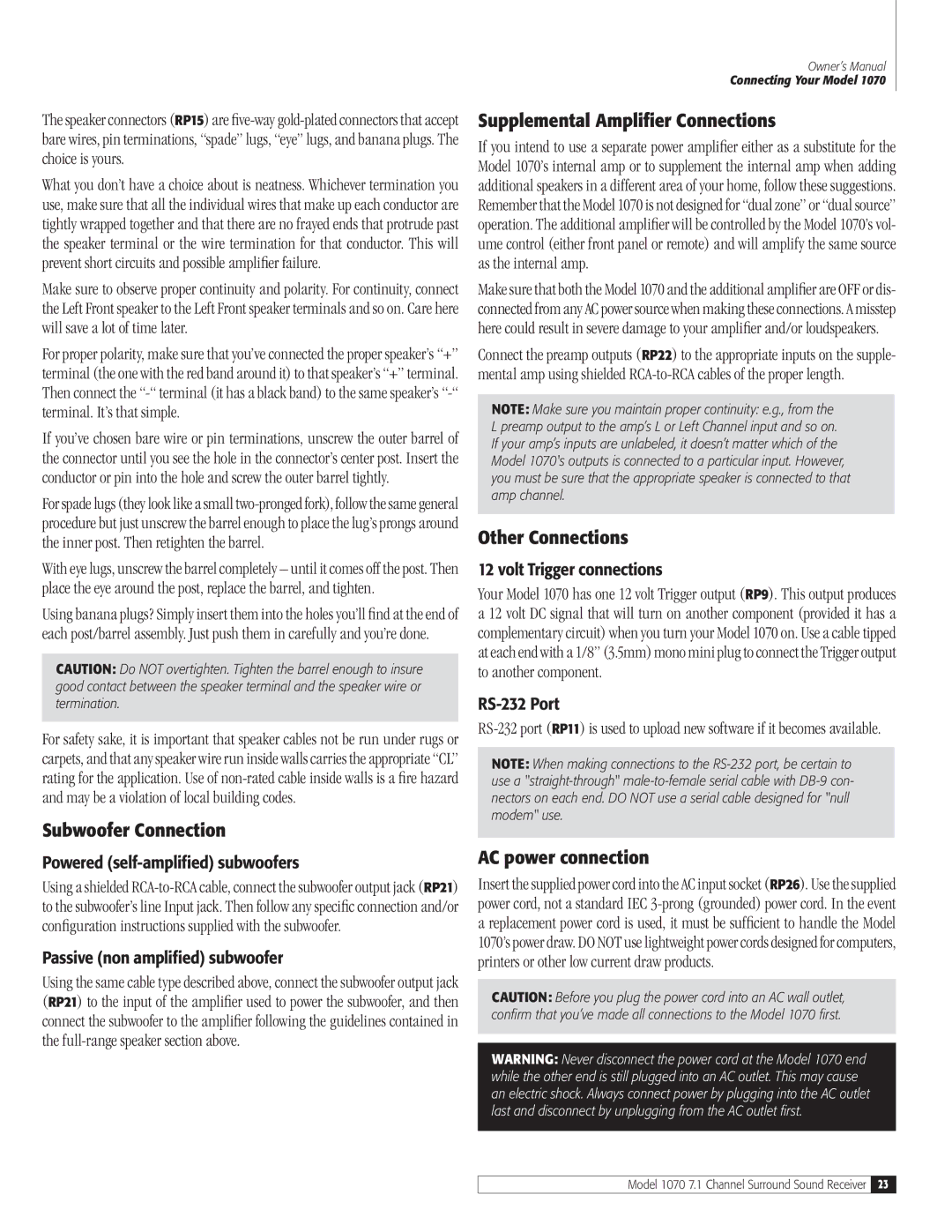The speaker connectors (RP15) are five-way gold-plated connectors that accept bare wires, pin terminations, “spade” lugs, “eye” lugs, and banana plugs. The choice is yours.
What you don’t have a choice about is neatness. Whichever termination you use, make sure that all the individual wires that make up each conductor are tightly wrapped together and that there are no frayed ends that protrude past the speaker terminal or the wire termination for that conductor. This will prevent short circuits and possible amplifier failure.
Make sure to observe proper continuity and polarity. For continuity, connect the Left Front speaker to the Left Front speaker terminals and so on. Care here will save a lot of time later.
For proper polarity, make sure that you’ve connected the proper speaker’s “+” terminal (the one with the red band around it) to that speaker’s “+” terminal. Then connect the “-“ terminal (it has a black band) to the same speaker’s “-“ terminal. It’s that simple.
If you’ve chosen bare wire or pin terminations, unscrew the outer barrel of the connector until you see the hole in the connector’s center post. Insert the conductor or pin into the hole and screw the outer barrel tightly.
For spade lugs (they look like a small two-pronged fork), follow the same general procedure but just unscrew the barrel enough to place the lug’s prongs around the inner post. Then retighten the barrel.
With eye lugs, unscrew the barrel completely – until it comes off the post. Then place the eye around the post, replace the barrel, and tighten.
Using banana plugs? Simply insert them into the holes you’ll find at the end of each post/barrel assembly. Just push them in carefully and you’re done.
CAUTION: Do NOT overtighten. Tighten the barrel enough to insure good contact between the speaker terminal and the speaker wire or termination.
For safety sake, it is important that speaker cables not be run under rugs or carpets, and that any speaker wire run inside walls carries the appropriate “CL” rating for the application. Use of non-rated cable inside walls is a fire hazard and may be a violation of local building codes.
Subwoofer Connection
Powered (self-amplified) subwoofers
Using a shielded RCA-to-RCA cable, connect the subwoofer output jack (RP21) to the subwoofer’s line Input jack. Then follow any specific connection and/or configuration instructions supplied with the subwoofer.
Passive (non amplified) subwoofer
Using the same cable type described above, connect the subwoofer output jack (RP21) to the input of the amplifier used to power the subwoofer, and then connect the subwoofer to the amplifier following the guidelines contained in the full-range speaker section above.
Owner’s Manual
Connecting Your Model 1070
Supplemental Amplifier Connections
If you intend to use a separate power amplifier either as a substitute for the Model 1070’s internal amp or to supplement the internal amp when adding additional speakers in a different area of your home, follow these suggestions. Remember that the Model 1070 is not designed for “dual zone” or “dual source” operation. The additional amplifier will be controlled by the Model 1070’s vol- ume control (either front panel or remote) and will amplify the same source as the internal amp.
Make sure that both the Model 1070 and the additional amplifier are OFF or dis- connected from any AC power source when making these connections. A misstep here could result in severe damage to your amplifier and/or loudspeakers.
Connect the preamp outputs (RP22) to the appropriate inputs on the supple- mental amp using shielded RCA-to-RCA cables of the proper length.
NOTE: Make sure you maintain proper continuity: e.g., from the L preamp output to the amp’s L or Left Channel input and so on. If your amp’s inputs are unlabeled, it doesn’t matter which of the Model 1070's outputs is connected to a particular input. However, you must be sure that the appropriate speaker is connected to that amp channel.
Other Connections
12 volt Trigger connections
Your Model 1070 has one 12 volt Trigger output (RP9). This output produces a 12 volt DC signal that will turn on another component (provided it has a complementary circuit) when you turn your Model 1070 on. Use a cable tipped at each end with a 1/8” (3.5mm) mono mini plug to connect the Trigger output to another component.
RS-232 Port
RS-232 port (RP11) is used to upload new software if it becomes available.
NOTE: When making connections to the RS-232 port, be certain to use a "straight-through" male-to-female serial cable with DB-9 con- nectors on each end. DO NOT use a serial cable designed for "null modem" use.
AC power connection
Insert the supplied power cord into the AC input socket (RP26). Use the supplied power cord, not a standard IEC 3-prong (grounded) power cord. In the event a replacement power cord is used, it must be sufficient to handle the Model 1070’s power draw. DO NOT use lightweight power cords designed for computers, printers or other low current draw products.
CAUTION: Before you plug the power cord into an AC wall outlet, confirm that you’ve made all connections to the Model 1070 first.
WARNING: Never disconnect the power cord at the Model 1070 end while the other end is still plugged into an AC outlet. This may cause an electric shock. Always connect power by plugging into the AC outlet last and disconnect by unplugging from the AC outlet first.

